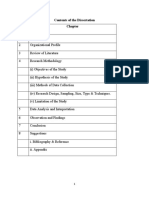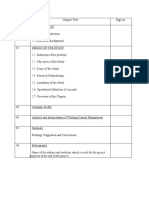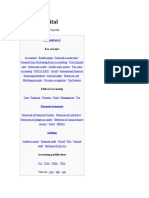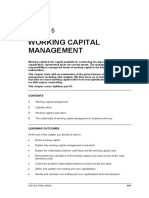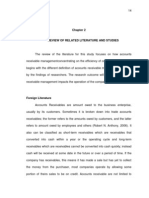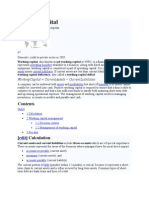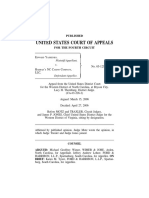BUS 4404 Learning Journal Unit 2
BUS 4404 Learning Journal Unit 2
Uploaded by
Cherry HtunCopyright:
Available Formats
BUS 4404 Learning Journal Unit 2
BUS 4404 Learning Journal Unit 2
Uploaded by
Cherry HtunCopyright
Available Formats
Share this document
Did you find this document useful?
Is this content inappropriate?
Copyright:
Available Formats
BUS 4404 Learning Journal Unit 2
BUS 4404 Learning Journal Unit 2
Uploaded by
Cherry HtunCopyright:
Available Formats
BUS 4404 – Principle of Finance 2
University of the People
Learning Journal Unit 2
The cash realization cycle, also known as the cash conversion cycle (CCC), is a critical
metric for businesses to manage their working capital and maintain liquidity. This cycle
measures the time taken between the initial investment in inventory and receiving payment from
customers for that inventory. It effectively captures the duration during which a business's funds
are tied up in inventory and accounts receivable before turning into cash.
Inventory turnover and accounts receivable collection are pivotal components of the cash
realization cycle. Inventory turnover refers to the rate at which a company's inventory is sold and
replaced over a period. A higher inventory turnover rate indicates efficient management of
inventory, meaning that the company is effective in converting its inventory into sales. Rapid
inventory turnover reduces the cash cycle duration, freeing up cash more quickly for other
business needs and reducing the holding costs associated with excess inventory (Walther &
Skousen, 2009).
Receivable collection plays a complementary role by influencing the speed at which cash is
recouped after sales are made. The receivables collection period measures the time taken to
collect cash from customers after a sale has been made. Shorter collection periods are preferable
as they indicate quicker cash inflow, enhancing a business's liquidity position. Efficient
receivables management ensures that businesses can reinvest the cash into operations, such as
purchasing more inventory or covering other operational expenses, without needing to rely
excessively on external financing (Morrow, 2012).
The integration of effective inventory management and swift receivable collection is
essential for minimizing the cash realization cycle. As businesses accelerate inventory turnover
and shorten the receivable collection period, they can significantly improve their cash flow. This
is crucial for maintaining liquidity and ensuring the company has enough cash on hand to meet
its short-term obligations and invest in growth opportunities. Managing these components
effectively allows businesses to operate more efficiently, reduce the cost of capital, and
potentially avoid financial distress (Volker, 2012).
References
Walther, L.M. & Skousen, C.J. (2009). Using Account Information. BookBoon: Ventus
Publishing ApS.
Morrow, R. (2012). Working Capital Management: A Must for Any Startup. Retrieved from
Volker, M.C. (2012). Making the Business Case. BookBoon: Ventus Publishing ApS.
You might also like
- Module 2 CFMADocument57 pagesModule 2 CFMAChristine Bea LimosNo ratings yet
- Celtic Wedding BlessingDocument4 pagesCeltic Wedding BlessingaelNo ratings yet
- Chapter 16 Credit AgreementsDocument56 pagesChapter 16 Credit AgreementsBekithemba MliloNo ratings yet
- Unit 2 LJ Bus 4404Document2 pagesUnit 2 LJ Bus 4404nikitaisabella8No ratings yet
- Working Capital Management by Birla GroupDocument39 pagesWorking Capital Management by Birla GroupHajra ShahNo ratings yet
- Chapter 9 10Document17 pagesChapter 9 10ainezerialc ngogupNo ratings yet
- New Research 2017Document19 pagesNew Research 2017SAKSHI GUPTANo ratings yet
- Learning Journal Unit 2 BUS 4404Document2 pagesLearning Journal Unit 2 BUS 4404Martina MakotaNo ratings yet
- Working Capital ManagementDocument7 pagesWorking Capital ManagementanjaliNo ratings yet
- FIN701 Finance: DIO (Average Inventory ÷ Cost of Goods Sold) X 365Document24 pagesFIN701 Finance: DIO (Average Inventory ÷ Cost of Goods Sold) X 365ankita chauhanNo ratings yet
- Literature Review: 2.1 Working CapitalDocument13 pagesLiterature Review: 2.1 Working CapitalKavya BajajNo ratings yet
- Cash Operating CycleDocument2 pagesCash Operating CycleAyman RamyNo ratings yet
- Aaa Working Capital ManagementDocument6 pagesAaa Working Capital Managementvictor marcoNo ratings yet
- The Working Capital CycleDocument5 pagesThe Working Capital Cycleormeco sodNo ratings yet
- Definition of 'Working Capital Management': CalculationDocument5 pagesDefinition of 'Working Capital Management': CalculationkulkarniashwiniNo ratings yet
- CH 15 - Narrative Report-Managing Working CapitalDocument12 pagesCH 15 - Narrative Report-Managing Working Capitaljomarybrequillo20No ratings yet
- Working CapitalDocument3 pagesWorking CapitalDeepthi RadhakrishnanNo ratings yet
- Working CapitalDocument49 pagesWorking CapitalRicha SharmaNo ratings yet
- WORKING CAPITAL MANAGEMENT of The Ultra Light Technology. VidishaDocument49 pagesWORKING CAPITAL MANAGEMENT of The Ultra Light Technology. Vidishasai projectNo ratings yet
- FM IIChapter FourDocument17 pagesFM IIChapter FourMoti BekeleNo ratings yet
- Phi Long WCWDocument48 pagesPhi Long WCWGia MinhNo ratings yet
- Working Capital: CalculationDocument3 pagesWorking Capital: CalculationrvgrockerNo ratings yet
- Working Capital Current Assets Net Working Capital Current Assets Current LiabilitiesDocument4 pagesWorking Capital Current Assets Net Working Capital Current Assets Current LiabilitiesMuhammad KhanNo ratings yet
- Operating Liquidity: Accounts Receivable Inventory Accounts PayableDocument4 pagesOperating Liquidity: Accounts Receivable Inventory Accounts PayableAman Kumar SharmaNo ratings yet
- Working Capital Management. (p2.2)Document58 pagesWorking Capital Management. (p2.2)hwezvamunyaradziNo ratings yet
- Aparajita - PPTX ManagementDocument8 pagesAparajita - PPTX Managementramshankarchauhan37No ratings yet
- Working Capital ManagementDocument57 pagesWorking Capital ManagementhwezvamunyaradziNo ratings yet
- Working Capital: CalculationDocument7 pagesWorking Capital: CalculationRobin SoumanNo ratings yet
- Working Capital Management AssignmentDocument10 pagesWorking Capital Management AssignmentRitesh Singh RathoreNo ratings yet
- Working Capital ManagementDocument12 pagesWorking Capital Managementankush_garg_36No ratings yet
- A Study On Working Capital ManagementDocument88 pagesA Study On Working Capital ManagementGopinath Basavaiah Siddaiah60% (5)
- Working CapitalDocument18 pagesWorking CapitalRevathi ManiNo ratings yet
- WC Management 1Document10 pagesWC Management 1RonakNo ratings yet
- Rakesh Final ProjectDocument60 pagesRakesh Final Projectmoorthysan143No ratings yet
- Financial Management AssignementDocument14 pagesFinancial Management AssignementHARSHINI KudiaNo ratings yet
- Working Capital ManagementDocument16 pagesWorking Capital ManagementRiannezel A. NavidadNo ratings yet
- Working Capital: Working Capital, Also Known As Net Working Capital or NWC, Is A FinancialDocument4 pagesWorking Capital: Working Capital, Also Known As Net Working Capital or NWC, Is A Financialneeleshku4No ratings yet
- Chapter 1.1 Working Capital Management 1.1 .1conceptDocument55 pagesChapter 1.1 Working Capital Management 1.1 .1conceptMAYUGAMNo ratings yet
- Working Capital ManagementDocument4 pagesWorking Capital ManagementFabia ArshadNo ratings yet
- Chapter 6 Short Term FinancingDocument19 pagesChapter 6 Short Term FinancingInes MiladiNo ratings yet
- SecondDocument49 pagesSecondGAURAV SHARMANo ratings yet
- Working Capital - IciciDocument7 pagesWorking Capital - IciciKhaisarKhaisarNo ratings yet
- Chapter 5 - Working Capital ManagementDocument24 pagesChapter 5 - Working Capital ManagementFatimah Rashidi VirtuousNo ratings yet
- Wor I King ModelDocument3 pagesWor I King ModelSrikanth KalaboinaNo ratings yet
- WCM Unit-LDocument6 pagesWCM Unit-Laanishkashyap61No ratings yet
- Working Capital DATADocument6 pagesWorking Capital DATASubhasis BiswalNo ratings yet
- Chapter 2Document17 pagesChapter 2JM Tomas Rubianes0% (1)
- FIN303 - Chap 14Document49 pagesFIN303 - Chap 14Hoang Thanh HangNo ratings yet
- Final Doc 47 WCDocument22 pagesFinal Doc 47 WCsravanikakarla731No ratings yet
- Financial Management II ModuleDocument104 pagesFinancial Management II ModuleObsa KamilNo ratings yet
- Harish YadacccccDocument60 pagesHarish YadacccccjubinNo ratings yet
- What Is Working Capital ManagementDocument3 pagesWhat Is Working Capital ManagementRohit BajpaiNo ratings yet
- Cash ManagementDocument5 pagesCash ManagementnpwrettiieeNo ratings yet
- Working CapitalDocument3 pagesWorking Capitalsurendra92No ratings yet
- Demo ProDocument21 pagesDemo ProTara HoodNo ratings yet
- Working Capital Management 2.1 PresentationDocument26 pagesWorking Capital Management 2.1 Presentationbeemajuru87No ratings yet
- LIM Busfin March16Document4 pagesLIM Busfin March16Kai BartolomeNo ratings yet
- Working Capital Management Notes PDFDocument40 pagesWorking Capital Management Notes PDFBarakaNo ratings yet
- KirloskarDocument29 pagesKirloskarShivsagar MukherjeeNo ratings yet
- What Is Liquidity?: IntroductionDocument5 pagesWhat Is Liquidity?: IntroductionNagesh PathakNo ratings yet
- Agricultural Financial Management BDocument25 pagesAgricultural Financial Management Bbryan rabonzaNo ratings yet
- Math Unit 5 Written AssignmentDocument6 pagesMath Unit 5 Written AssignmentCherry HtunNo ratings yet
- PSYC 1504 Written Assignment Unit 7Document4 pagesPSYC 1504 Written Assignment Unit 7Cherry HtunNo ratings yet
- MATH 1201 Written Assignment Unit 5Document8 pagesMATH 1201 Written Assignment Unit 5Cherry HtunNo ratings yet
- BUS 2201 Written Assignment Unit 2Document6 pagesBUS 2201 Written Assignment Unit 2Cherry HtunNo ratings yet
- BUS 2202 Written Assignment Unit 1Document7 pagesBUS 2202 Written Assignment Unit 1Cherry HtunNo ratings yet
- BUS 1105 Written Assignment Unit 1Document5 pagesBUS 1105 Written Assignment Unit 1Cherry HtunNo ratings yet
- BUS 1105 Learning Journal Unit 3Document6 pagesBUS 1105 Learning Journal Unit 3Cherry HtunNo ratings yet
- BUS 4404 Written Assignment Unit 1Document4 pagesBUS 4404 Written Assignment Unit 1Cherry HtunNo ratings yet
- SOC 1502 Learning Journal Unit 3Document4 pagesSOC 1502 Learning Journal Unit 3Cherry HtunNo ratings yet
- POLS 1503 Learning Journal Unit 8Document8 pagesPOLS 1503 Learning Journal Unit 8Cherry HtunNo ratings yet
- POLS 1503 Learning Journal Unit 5Document7 pagesPOLS 1503 Learning Journal Unit 5Cherry HtunNo ratings yet
- BUS 2201 Discussion Forum Unit 3Document2 pagesBUS 2201 Discussion Forum Unit 3Cherry HtunNo ratings yet
- Basic AccountingDocument3 pagesBasic AccountingCherry HtunNo ratings yet
- BUS 2201 Discussion Forum Unit 2Document1 pageBUS 2201 Discussion Forum Unit 2Cherry HtunNo ratings yet
- BUS 2201 Discussion Forum Unit 1Document2 pagesBUS 2201 Discussion Forum Unit 1Cherry HtunNo ratings yet
- BUS 2201 Dis Forum Unit 4Document2 pagesBUS 2201 Dis Forum Unit 4Cherry HtunNo ratings yet
- The Plague of Athens: Epidemiology and PaleopathologyDocument13 pagesThe Plague of Athens: Epidemiology and PaleopathologyCherry HtunNo ratings yet
- People v. Germina, 290 SCRA 146 (1998)Document3 pagesPeople v. Germina, 290 SCRA 146 (1998)Kristine May CisterNo ratings yet
- Integration SheetDocument68 pagesIntegration SheetMayank Shahabadee100% (1)
- Zemea (R) Propanediol Product Data SheetDocument1 pageZemea (R) Propanediol Product Data SheetoviangstaNo ratings yet
- Corpus v. Sto. TomasDocument2 pagesCorpus v. Sto. TomasChariNo ratings yet
- Jurnal Eksistensi Komisi YudisialDocument13 pagesJurnal Eksistensi Komisi Yudisialindra utamaNo ratings yet
- Ulep vs. Legal ClinicDocument2 pagesUlep vs. Legal ClinicAnne Renee SuarezNo ratings yet
- Anandam Case StudyDocument12 pagesAnandam Case Studythamil marpanNo ratings yet
- Yashenko v. Harrah's NC Casino, 4th Cir. (2006)Document17 pagesYashenko v. Harrah's NC Casino, 4th Cir. (2006)Scribd Government DocsNo ratings yet
- Maxims of Commercial LawDocument4 pagesMaxims of Commercial LawAkil Bey100% (3)
- Discretionary Administrative Powers 29.10.2020Document85 pagesDiscretionary Administrative Powers 29.10.2020bhagwat gawaliNo ratings yet
- Hostel Accommodation Form - 2022-23Document2 pagesHostel Accommodation Form - 2022-23Akshay KumarNo ratings yet
- Neri v. Heirs of HadjiDocument1 pageNeri v. Heirs of HadjiTintin MendozaNo ratings yet
- Radio ComsDocument1 pageRadio Coms801st Manuever CompanyNo ratings yet
- PhiloDocument3 pagesPhilodll1230% (1)
- Calero Vs CarionDocument9 pagesCalero Vs CarionStrawberryNo ratings yet
- Circular Instructions On Leases, Licenses and Other RightsDocument3 pagesCircular Instructions On Leases, Licenses and Other Rightsdv_bhaskar1845No ratings yet
- SMEC Automation Pvt. Ltd. 2nd Floor, Kaloor Busstand Complex Kaloor, Cochin 682017 Mob: 9605550001Document1 pageSMEC Automation Pvt. Ltd. 2nd Floor, Kaloor Busstand Complex Kaloor, Cochin 682017 Mob: 9605550001Venkata Dheeraj OgiralaNo ratings yet
- US Vs VedraDocument2 pagesUS Vs VedraDivina Gracia HinloNo ratings yet
- Judges Transfer CaseDocument3 pagesJudges Transfer CasesarayooNo ratings yet
- Racing Motorbike Pattern - Puntosdefantasia - English - CompressedDocument18 pagesRacing Motorbike Pattern - Puntosdefantasia - English - CompressedFrancesca Cecchet100% (1)
- Chapter 7 LeverageDocument21 pagesChapter 7 Leveragemuluken walelgnNo ratings yet
- Summary-The Year of The WeedsDocument4 pagesSummary-The Year of The WeedsSeetaram Saathvik KommanaNo ratings yet
- Kim Affidavit - For ReviewDocument2 pagesKim Affidavit - For Reviewtimothyhankins888No ratings yet
- Botkins Environmental Science Summary Chapter 1-7Document2 pagesBotkins Environmental Science Summary Chapter 1-7Ella CardenasNo ratings yet
- Advanced Broken - Wing Butterfly Spreads - Random Walk TradingDocument8 pagesAdvanced Broken - Wing Butterfly Spreads - Random Walk TradingjprakashusNo ratings yet
- PETRONAS Licensing and Registration General Guidelines (English Version - As at 1 June 2017)Document41 pagesPETRONAS Licensing and Registration General Guidelines (English Version - As at 1 June 2017)Adilah AzamiNo ratings yet
- Illustration: End of Pol Year Attained Age Annual Premium Guaranteed Critical Illness BenefitDocument1 pageIllustration: End of Pol Year Attained Age Annual Premium Guaranteed Critical Illness BenefitRon CatalanNo ratings yet
- Dubai General Visitors Checklist Feb 2010Document4 pagesDubai General Visitors Checklist Feb 2010Waqas1992No ratings yet


















